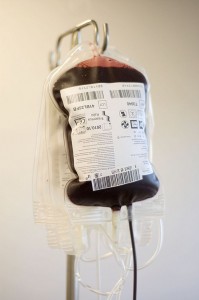
On April 22, Jason Stephany, a researcher in a yeast lab, received an email from his co-worker, a woman whose husband has a fast-growing blood cancer called acute lymphoblastic leukemia (ALL). She explained that her husband would need a bone marrow transplant. In patients with ALL, the bone marrow produces hordes of immature white blood cells that crowd out normal cells. Many drugs exist to fight the disease, but the only cure is to replace the cancerous marrow with healthy marrow from a donor. Stephany and his co-workers were unlikely to be a match for the woman’s husband, but she encouraged them to join the national bone marrow registry anyway. “You will be a hero for saving a life somewhere in the world and maybe this will help people to be more involved,” she wrote. Stephany thought it sounded like a good idea. But when he visited the registry’s web page, he found he was ineligible. Stephany is gay.
The Food and Drug Administration policy that prohibits men who have sex with men* from donating blood and bone marrow dates back to the early 1980s, when the AIDS epidemic first began. AIDS wasn’t even AIDS back then. Physicians were calling it “gay-related immune deficiency” or GRID, because it seemed to occur only among gay men. Stephany, who was born in 1981, was barely walking when the policy took shape.

Back then, banning gay men from donating blood made some sense. Blood banks didn’t have tests to screen for HIV until 1985. And these early tests had limitations. They were designed to detect antibodies against HIV, but the body doesn’t produce antibodies right away. It takes some time. So a person could become infected with the virus and not test HIV positive for many months. (Antibody tests are still the way doctors test people for HIV, but blood is subject to more sensitive tests.) This so-called “window period” — the time between infection and detection — worried health officials.
Today the window period has shrunk dramatically. All blood centers now use two tests to screen for HIV. The more sensitive test, which searches for components of the virus rather than viral antibodies, can detect HIV just two to three weeks after infection. Yet the ban persists. On its web site, the FDA points out that even state-of-the-art HIV tests can’t detect every case of HIV. And the agency notes that the prevalence of HIV among men who have sex with men is 60 times higher than the general population and 800 times higher than first-time blood donors. The implication is that allowing men who have sex with men to donate would put the blood supply at risk.
Stephany knew about the FDA policy, but he hadn’t tried to donate blood in several years. When he visited the bone marrow registry, he hoped to find the ban had been lifted. When he found out it hadn’t, he was livid. He sat down and typed an email to the FDA. “I am disappointed to find out that you still deny homosexual men the opportunity to donate their bone marrow. This is particularly frustrating knowing that there are currently tests that can identify HIV three weeks into infection,” he wrote. “Get off your hetero-normative asses and fix a broken link in your system.” Then he got on Facebook. “AAAAARRRGGG! Really pissed that i cannot be part of the bone marrow registry, or donate blood. For realz?” he wrote.
Stephany’s Facebook post was the first I heard of the ban. To me, the policy seems hopelessly antiquated. And I am not alone. The American Red Cross and America’s Blood Centers, which together account for 90% of the US blood supply, have been saying the ban is “medically and scientifically unwarranted” since 2006. Yes, men who have sex with men have a higher risk of HIV. But so do lots of groups, and not all of them are subject to the same lifetime ban.

Last year, the US Department of Health and Human Services Advisory Committee on Blood Safety and Availability held a meeting to re-examine the issue. In a letter to HHS, Senator John Kerry, one of forty lawmakers who has called on the FDA to revise the policy, pointed out that “a woman who has sexual relations with a male she knows to be HIV positive is deferred for one year, while a gay man who has had sexual relations with a healthy, monogamous male partner is deferred for life.” The double standard is clear. Yet committee members voted to keep the ban in place.
The American Red Cross and America’s Blood Centers support a one-year waiting or “deferral” period on donations after male-to-male sex. According to a study by the Williams Institute, instituting a one-year deferral period for men who have sex with men would yield an estimated 89,000 additional pints of blood annually. Bioethicist Arthur Caplan has argued for a 60-day deferral for everyone who has engaged in behavior that might put them at risk for contracting HIV. And that seems sensible. After all, the policy already relies on the honor system. So why not inform potential donors of risky behaviors and then require a deferral period for everyone who meets the criteria?
For many people with leukemia, finding a matching bone marrow donor can mean the difference between life and death. For these men and women, the small risk of contracting HIV would likely outweigh the much larger risk of dying from cancer. Why not let the marrow recipients decide? The bone marrow registry could allow gay men to register and note in their files that the donor has had sexual contact with men. Then the family could decide whether to take the risk.
If you’d like to register for the national bone marrow registry, you can sign up here.
—
*Public health officials use the term ‘men who have sex with men’ rather than ‘gay’ because it encompasses men who might be bisexual and men who sleep with men but don’t identify themselves as gay. The term is rather awkward, but I get their point.
Image of Jason Stephany: Seattle Quake Rugby.
Image of donated blood: César Astudillo, Wikimedia Commons
Image of Nottingham protest: Matt Buck, Wikimedia Commons
It is terrible, really terrible to see that the ban is still not lifted. Another example in the despicably long list of double standards our government operates under.
And a sidenote: maybe a Facebook “like” button isn’t the best way to share this article. 😉
I tried to give blood after first moving to the US and was told I couldn’t since I’d been with a man who’d been with another man. Well phooey! My blood was good enough back home in Canada but apparently tainted by my non-bigoted attitude down here. I’ve never bothered to give blood since because I find the whole thing so ugly and mean-spirited.
Several years ago I heard an NPR story about AIDS being on the rise in the African-American female population but I saw no ban there, because that would have been racist and stupid. Keeping up this ban is anti-gay and stupid. Not much any of us can do, though, but spread the word…